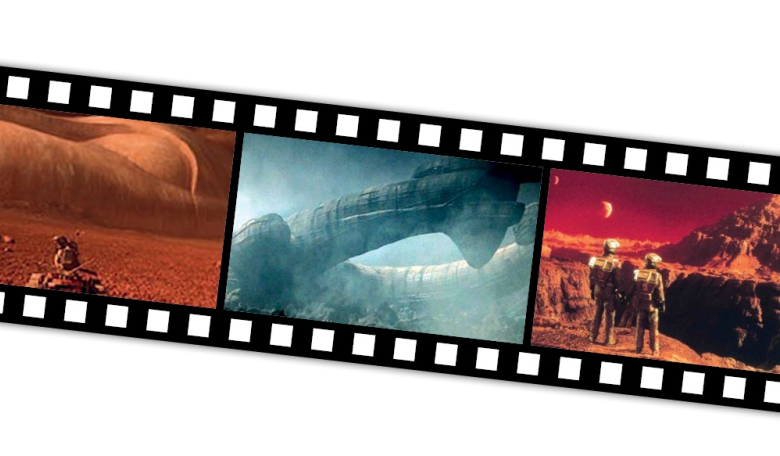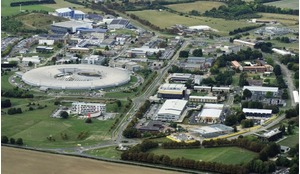New discoveries and expanding knowledge in astronomy have fostered debate and research on extraterrestrial life and have also revived the sources of inspiration of science fiction cinema. In this article the authors review selected films and episodes of television series that develop the theme of research and the discovery of extraterrestrial civilisations and their various consequences to discuss their pertinence to current knowledge in astrobiology.
Even before the Second World War, science fiction literature was combining exoticism and the adventure of archaeological expeditions in search of lost civilisations with the search and discovery of extraterrestrial civilisations. The combination of the rise of science fiction cinema during the second half of the 20th century, increased fascination with the ruins of extinct civilisations and increased interest in ‘ufology’ all came together in some sci-fi plots showing discoveries of the remains of alien civilisations.
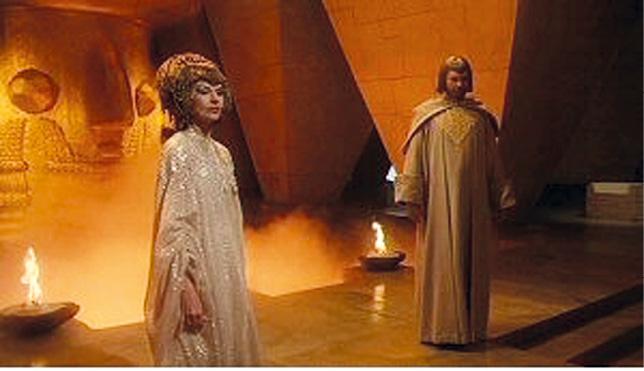 Queen Atsil and Atraxon in the hall of the Atlantean city of Vaar (right) from the film Warlords of Atlantis.
Queen Atsil and Atraxon in the hall of the Atlantean city of Vaar (right) from the film Warlords of Atlantis.
Films relating the discovery of remains of civilisations of extraterrestrial origin are inspired in particular by the theory of ancient astronauts, developed in the 1960s and especially popularised by Erich von Daniken (1968).
According to this pseudo-scientific and ufological theory, extraterrestrials visitors would have transmitted scientific and technical knowledge to several prehistoric and ancient civilisations. Ancient Egypt, with its very old and monumental civilisation has attracted the interest of the proponents of the theory of ancient astronauts, and thus of adventure cinema, archaeology fiction and science fiction.
For example, the scenario for the film Stargate is based on the discovery in Egypt of a mysterious ring. This ring proves to be a ‘stargate’, an interplanetary transport device invented about 60 million years ago by an alien civilisation called the ‘Ancients’. Although theoretical, the concept of wormholes, referred to in this case, is widely used in science fiction to allow space-time travel.
 Pyramid, pylon and obelisks on the planet Abydos, from Stargate.
Pyramid, pylon and obelisks on the planet Abydos, from Stargate.
Myth of Atlantis and ancient astronauts
The notion of the discovery of remains of extraterrestrial civilisations on other planets has inspired the plots of many science fiction films since the middle of the 20th century, even before the beginning of space exploration
The origin of the myth of Atlantis is a set of two philosophical accounts of Plato (428-348 BC), the dialogues of Timaeus and Critias, which set out how Athens stopped the belligerent expansionism of the people from the island of Atlantis, an island that Plato located beyond the Columns of Hercules. According to the myth, after the victory of Athens against the Atlanteans, a cataclysm caused by Zeus engulfed Atlantis in the ocean.
 A film still from The Thing showing the alien creature in one of its forms.
A film still from The Thing showing the alien creature in one of its forms.
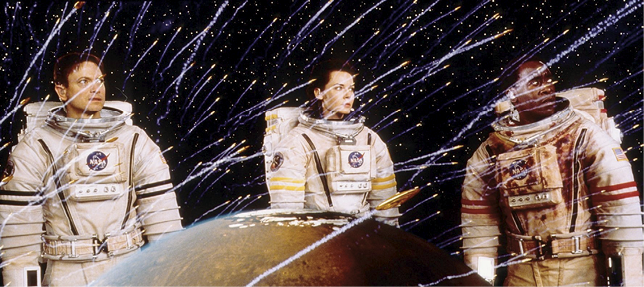 Inside the face: holographic representation of the take-off and flight of Martian spaceships after the impact event in Mission to Mars.
Inside the face: holographic representation of the take-off and flight of Martian spaceships after the impact event in Mission to Mars.
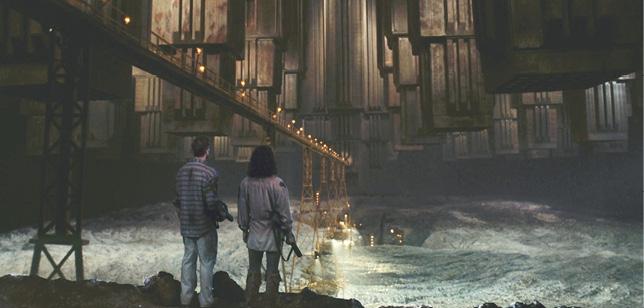 The powerplant built by the lost alien civilisation inside Pyramid Mountain, from Total Recall.
The powerplant built by the lost alien civilisation inside Pyramid Mountain, from Total Recall.
Rediscovered in the Western world during the Renaissance, the myth of Atlantis has been the subject of the most diverse speculations, until being revisited by the theoreticians of ancient astronauts. Thus, the film Warlords of Atlantis, while retaining the classic location of the sunken city in the Atlantic Ocean, proposed an extraterrestrial origin to the Atlantean.
In the film, set in 1896, British archaeologists Professor Aitken and his son Charles discover a gold statue at the bottom of the Atlantic Ocean that points to the entrance of an underwater gallery leading to the remains of Vaar, one of the seven cities of Atlantis having not been completely engulfed in the ocean and still inhabited. Queen Atsil explains to Charles Aitken that her ancestors had to leave their home planet, Mars, following the fall of a meteorite that caused a global disaster and made their planet uninhabitable.
Alien contact and biological hazards
Science fiction is a powerful tool for educational exploration of the risks that could weigh on the future of humanity
John Carpenter’s The Thing highlights the biological risks of contact with an unknown extraterrestrial life form. The risk of biological contamination both from and to Earth is taken very seriously by organisations such as NASA and the European Space Agency, for all space missions, in the sense of contamination from Earth on other planets, as well as contamination of extraterrestrial origin upon return from certain missions.
In this story, the wreckage of a spaceship buried under Antarctic ice for at least 100,000 years is discovered by scientists from a Norwegian base, then rediscovered by scientists from an American base. Archives left by the Norwegian team suggest that one of the occupants of the spaceship was ejected when it crashed on Earth. This ‘thing’ was extracted from the ice by the Norwegian researchers, and was the vector of a rapid contamination (by simple contact) by a parasite of extraterrestrial origin.
Xenoarchaeology consists of searching for material traces of extinct extraterrestrial civilisations. The search for traces or remains of such civilisations is seriously considered in research programmes of NASA and the SETI Institute. The notion of the discovery of remains of extraterrestrial civilisations on other planets has inspired the plots of many science fiction films since the middle of the 20th century, even before the beginning of space exploration (e.g. Forbidden Planet in 1956).
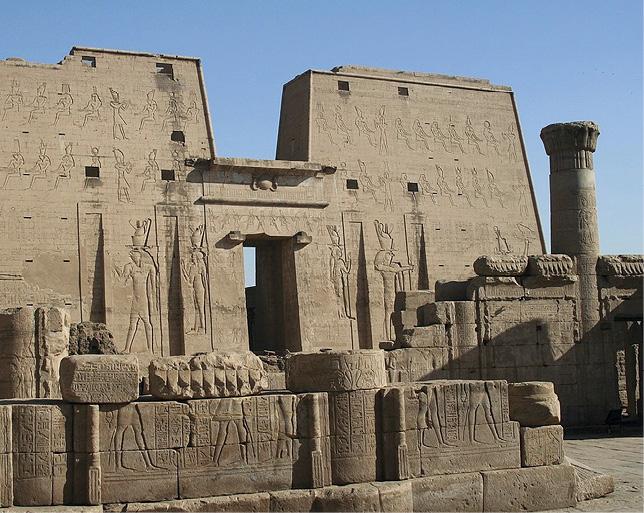 Pylon of the temple of Horus in Edfu, Egypt. Archaeological discoveries on the fictional exoplanet Abydos were directly inspired by the architecture of ancient Egypt in the film Stargate.
Pylon of the temple of Horus in Edfu, Egypt. Archaeological discoveries on the fictional exoplanet Abydos were directly inspired by the architecture of ancient Egypt in the film Stargate.
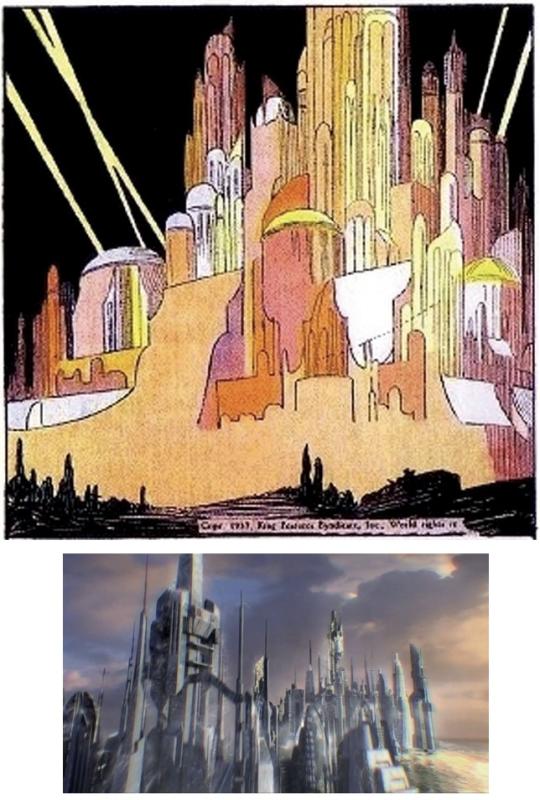
Mythical red planet
Various theories and hypotheses have been explored in science fiction cinema, almost always with the discovery of remains or traces of extraterrestrial civilisations
Although the hypothesis of Martian ‘canals’ as proof of possible presence of a Martian civilisation, was definitively discarded from the beginning of the 20th century, literature and then science fiction cinema continued to imagine Martian civilisations. The film Mission to Mars refers to the ‘Face of Mars’, a Martian relief called ‘Cydonia Mensae’ that was photographed by the orbiter Viking I on 25 July 1976.
In the film, the ‘Face’ is a sanctuary containing the archives of an ancient Martian civilisation. A group of astronaut explorers learn that Mars was inhabited until the cataclysmic fall of a meteorite that forced the survivors to migrate.
The evocation of a face in the photograph taken by the Viking I probe quickly became the object of theories and speculations on the possible artificial character of this formation and, by extension, evidence of a long-extinct Martian civilisation. The presence of pyramid-shaped rock formations in the same Martian region of Cydonia may have suggested the existence of monumental remains of a large ancient city.
Martian pyramidal rock formations were used as the setting for the film Total Recall and in the context of a human colonisation of Mars, the excavation of galleries under the Pyramid Mountain gave access to a gigantic reactor built by an alien civilisation that had disappeared from the planet several hundred thousand years before.
Unfortunately for lovers of extraterrestrial civilisations, higher resolution photos taken on 5 April 1998 and 8 April 2001, by the Mars Global Surveyor probe, confirmed that the face of Mars was only an eroded hill or mesa whose shading effects could, by pareidolia, evoke a human face. As for pyramids, erosion is also responsible for these forms of relief.
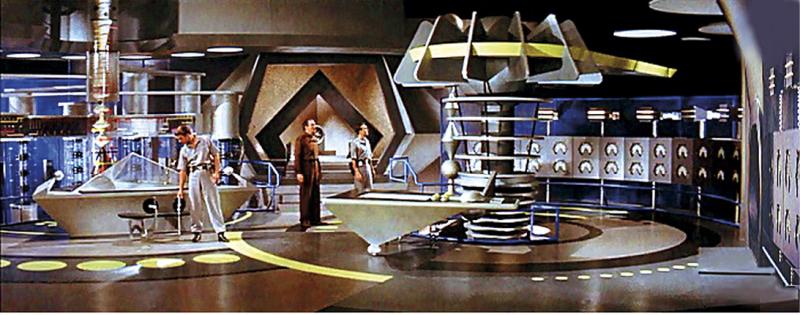 The Krell laboratory on the exoplanet Altair IV, from Forbidden Planet, directed by Fred M. Wilcox, production company: Metro-Goldwyn-Mayer; USA, 1956.
The Krell laboratory on the exoplanet Altair IV, from Forbidden Planet, directed by Fred M. Wilcox, production company: Metro-Goldwyn-Mayer; USA, 1956.
Exoplanetary archaeology
The risk of biological contamination both from and to Earth is taken very seriously by organisations such as NASA and the European Space Agency for all space missions
The first exoplanet (51 Pegasi b) was discovered and confirmed in 1995, but some Greek philosophers and scholars of antiquity had already sensed its existence. Democritus (c. 460-370 BC), Epicurus (342/341-270 BC), and Aristarchus of Samos (c. 310-230 BC) seem to have already been convinced of the plurality of worlds.
In the film Stargate and its sequels in the form of the television series, Stargate SG-1 and Stargate Atlantis, archaeological remains on Earth allow scientists to discover the extrasolar origin of their builders. Egyptian antiquity and the myth of Atlantis are sources of inspiration.
In the film Stargate the monumental complex discovered on the exoplanet Abydos is directly inspired by the architecture of ancient Egypt. The television series Stargate Atlantis offers an extraterrestrial version of the sunken city, discovered on the exoplanet Lantia. However, the Stargate version of the city of Atlantis, seems straight out of the 1930s comic strip Flash Gordon rather than Plato’s imagination.
The film Forbidden Planet also imagines the discovery of xenoarchaeological remains on an exoplanet, but without any connection with Earth’s antiquity and its myths. In the 23rd century, a scientific expedition discovers on the exoplanet Altair IV the remains of a very old, technologically advanced alien civilisation, the Krells, who disappeared suddenly more than 200,000 years before. The scenario of Forbidden Planet thus presents some common points with that of Total Recall, with the discovery of a giant machine built by a lost extraterrestrial civilisation.
In Ridley Scott’s Alien and its prequel Prometheus, a xenoarchaeological discovery is the context to show the dangerous consequences of contact with unknown life forms. In Alien the space cargo ship Nostromo receives a radio signal emitted from LV-426, an exomoon located in the binary system of Zeta Reticuli, 39.5 light-years from Earth. Searching for the signal source on the surface of the planet, three crew members discover the wreckage of an alien vessel, within which is an enormous alien egg chamber. In the famous ‘face hugger’ scene the opening of one of the eggs releases a creature that clings to the face of the executive officer, and the subsequent violation of a mandatory quarantine then allows the introduction of the creature onto the Nostromo, with devastating results.
A chain of unforeseen events, unfortunate decisions and catastrophic consequences is also the basic plot line followed by The Thing (released three years later), with science fiction horror, discovery of a spaceship of unknown origin abandoned for thousands of years, and discovery of an unknown and dangerous parasitic life form.
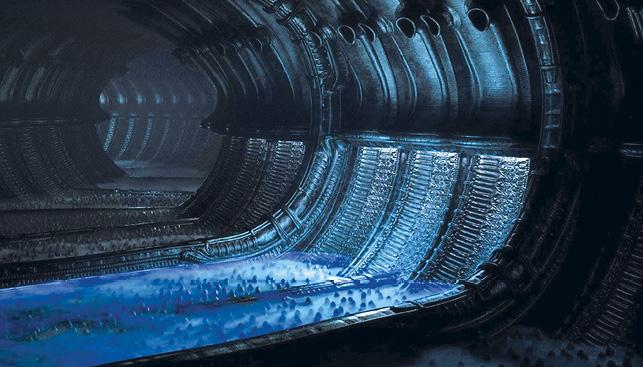 Large room lined with eggs inside the alien spaceship.Image from Alien, directed by Ridley Scott, production companies: Brandywine Productions and 20th Century Fox; USA and UK, 1979.
Large room lined with eggs inside the alien spaceship.Image from Alien, directed by Ridley Scott, production companies: Brandywine Productions and 20th Century Fox; USA and UK, 1979.
Fertile imaginations
Distinguishing science from fiction in the scenarios of films and television series also highlights some of the warnings concerning, for example, the risks of biological contamination and specific technological threats
Cinema and television series have approached and developed the theme of the discovery of remains or traces of extraterrestrial civilisations from an archaeological point of view. The list would, of course, be much longer if we consider all the scenarios of direct encounters with extraterrestrial civilisations.
No concrete evidence, neither material nor archaeological in particular, has yet been able to attest to the existence of such societies. Various theories and hypotheses have been explored in science fiction cinema, almost always with the discovery of remains or traces of extraterrestrial civilisations.
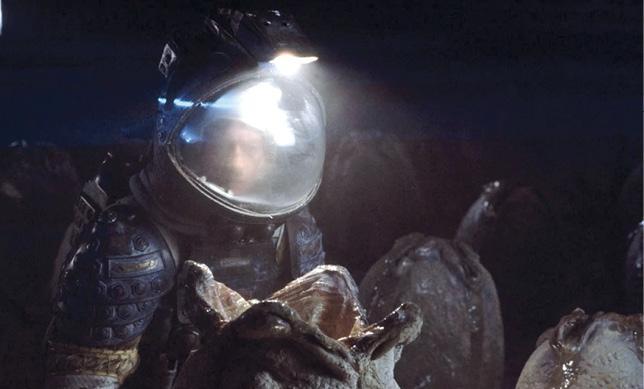 Alien egg opening in front of Executive Officer Kane. Image from Alien.
Alien egg opening in front of Executive Officer Kane. Image from Alien.
The fertile imagination of the world of science fiction cinema has abundantly adapted the most fanciful ufological theories such as ancient astronauts. Distinguishing science from fiction in the scenarios of films and television series also highlights some of the warnings concerning, for example, the risks of biological contamination and specific technological threats.
Although no life form has yet been discovered elsewhere than on Earth, this makes some film scenarios partially plausible. Indeed, science fiction is a powerful tool for educational exploration of the risks that could weigh on the future of humanity.
Editor’s note
This article is an edited version of a more detailed paper entitled ‘Alien archaeology in science fiction cinema’, by the same authors , published in the journal Art & Science (2024), and including a full list of references - https://www.openscience.fr
About the authors
Olivier Planchon is a researcher for the National Centre for Scientific Research (CNRS) at the Biogéosciences laboratory of the University of Burgundy, Dijon, France. His research focuses on the space-time dynamics of climate at regional and local scales, especially on atmospheric circulation patterns and climate variability in wine-producing areas, connections between atmospheric circulation patterns and weather types, and climate risks and impacts (e.g. late frosts, heat waves, vegetation phenology). He is also interested in palaeoclimatology, the history of sciences (research on the knowledge of meteorology and climatology in the ancient world), and ‘cinema & science’, i.e. research on likelihood and implausibility by reviewing fact versus fiction in films and television series.
Christophe Thomazo is an Associate Professor at the Biogeosciences Laboratory, University of Burgandy, Dijon, France. His expertise lies in the analysis of traditional stable isotopes (hydrogen, carbon, nitrogen, oxygen, and sulphur) of sedimentary archives in order to place constraints on the biological and geochemical evolution of Earth’s surface environments. He is particularly interested in the early evolution of the nitrogen cycle, the mechanisms of oxygenation of the terrestrial atmosphere and their consequences on the biosphere and biogeochemical cycles in general.
Pierre Pouzet is an associate professor in the LabISEN laboratory at ISEN, Carquefou, France. As a member of the multidisciplinary KLaIM research group his research focuses on environmental changes in sensitive environments. He studies the processes influencing extreme forces in coastal environments, as well as the detection and spatialisation of their impacts over several temporalities. His research contributes to refining the evaluation of the spatial and temporal evolution of natural and anthropogenic hazards in sensitive areas, and to the understanding of human adaptation to these issues.
Cécile Allinne is an archaeologist of the Roman period, studying the way in which societies perceived and exploited the natural environments in which they lived. She is particularly interested in people’s reactions to the risks involved by the transformations of these environments, as a result of natural disasters or climate change. This approach requires the reconstruction of ancient landscapes.





